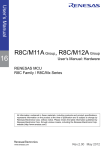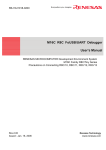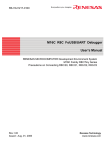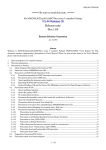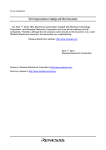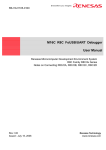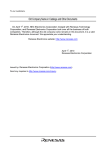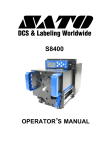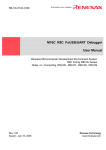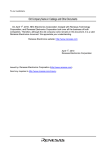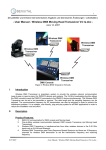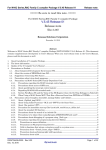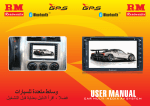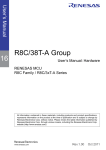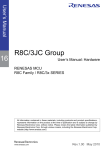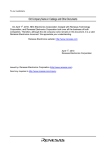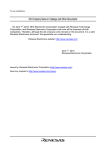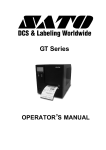Download M16 R8C FoUSB/UART Debugger User Manual
Transcript
User’s Manual 16 M16C R8C UART Debugger User’s Manual Renesas Microcomputer Development Environment System R8C Family / R8C/Mx Series Notes on Connecting R8C/M11A, M12A Group All information contained in these materials, including products and product specifications, represents information on the product at the time of publication and is subject to change by Renesas Electronics Corp. without notice. Please review the latest information published by Renesas Electronics Corp. through various means, including the Renesas Technology Corp. website (http://www.renesas.com). www.renesas.com Rev.1.00 Feb 2011 Notice 1. 2. 3. 4. 5. 6. 7. All information included in this document is current as of the date this document is issued. Such information, however, is subject to change without any prior notice. Before purchasing or using any Renesas Electronics products listed herein, please confirm the latest product information with a Renesas Electronics sales office. Also, please pay regular and careful attention to additional and different information to be disclosed by Renesas Electronics such as that disclosed through our website. Renesas Electronics does not assume any liability for infringement of patents, copyrights, or other intellectual property rights of third parties by or arising from the use of Renesas Electronics products or technical information described in this document. No license, express, implied or otherwise, is granted hereby under any patents, copyrights or other intellectual property rights of Renesas Electronics or others. You should not alter, modify, copy, or otherwise misappropriate any Renesas Electronics product, whether in whole or in part. Descriptions of circuits, software and other related information in this document are provided only to illustrate the operation of semiconductor products and application examples. You are fully responsible for the incorporation of these circuits, software, and information in the design of your equipment. Renesas Electronics assumes no responsibility for any losses incurred by you or third parties arising from the use of these circuits, software, or information. When exporting the products or technology described in this document, you should comply with the applicable export control laws and regulations and follow the procedures required by such laws and regulations. You should not use Renesas Electronics products or the technology described in this document for any purpose relating to military applications or use by the military, including but not limited to the development of weapons of mass destruction. Renesas Electronics products and technology may not be used for or incorporated into any products or systems whose manufacture, use, or sale is prohibited under any applicable domestic or foreign laws or regulations. Renesas Electronics has used reasonable care in preparing the information included in this document, but Renesas Electronics does not warrant that such information is error free. Renesas Electronics assumes no liability whatsoever for any damages incurred by you resulting from errors in or omissions from the information included herein. Renesas Electronics products are classified according to the following three quality grades: “Standard”, “High Quality”, and “Specific”. The recommended applications for each Renesas Electronics product depends on the product’s quality grade, as indicated below. You must check the quality grade of each Renesas Electronics product before using it in a particular application. You may not use any Renesas Electronics product for any application categorized as “Specific” without the prior written consent of Renesas Electronics. Further, you may not use any Renesas Electronics product for any application for which it is not intended without the prior written consent of Renesas Electronics. Renesas Electronics shall not be in any way liable for any damages or losses incurred by you or third parties arising from the use of any Renesas Electronics product for an application categorized as “Specific” or for which the product is not intended where you have failed to obtain the prior written consent of Renesas Electronics. The quality grade of each Renesas Electronics product is “Standard” unless otherwise expressly specified in a Renesas Electronics data sheets or data books, etc. “Standard”: 8. 9. 10. 11. 12. Computers; office equipment; communications equipment; test and measurement equipment; audio and visual equipment; home electronic appliances; machine tools; personal electronic equipment; and industrial robots. “High Quality”: Transportation equipment (automobiles, trains, ships, etc.); traffic control systems; anti-disaster systems; anticrime systems; safety equipment; and medical equipment not specifically designed for life support. “Specific”: Aircraft; aerospace equipment; submersible repeaters; nuclear reactor control systems; medical equipment or systems for life support (e.g. artificial life support devices or systems), surgical implantations, or healthcare intervention (e.g. excision, etc.), and any other applications or purposes that pose a direct threat to human life. You should use the Renesas Electronics products described in this document within the range specified by Renesas Electronics, especially with respect to the maximum rating, operating supply voltage range, movement power voltage range, heat radiation characteristics, installation and other product characteristics. Renesas Electronics shall have no liability for malfunctions or damages arising out of the use of Renesas Electronics products beyond such specified ranges. Although Renesas Electronics endeavors to improve the quality and reliability of its products, semiconductor products have specific characteristics such as the occurrence of failure at a certain rate and malfunctions under certain use conditions. Further, Renesas Electronics products are not subject to radiation resistance design. Please be sure to implement safety measures to guard them against the possibility of physical injury, and injury or damage caused by fire in the event of the failure of a Renesas Electronics product, such as safety design for hardware and software including but not limited to redundancy, fire control and malfunction prevention, appropriate treatment for aging degradation or any other appropriate measures. Because the evaluation of microcomputer software alone is very difficult, please evaluate the safety of the final products or system manufactured by you. Please contact a Renesas Electronics sales office for details as to environmental matters such as the environmental compatibility of each Renesas Electronics product. Please use Renesas Electronics products in compliance with all applicable laws and regulations that regulate the inclusion or use of controlled substances, including without limitation, the EU RoHS Directive. Renesas Electronics assumes no liability for damages or losses occurring as a result of your noncompliance with applicable laws and regulations. This document may not be reproduced or duplicated, in any form, in whole or in part, without prior written consent of Renesas Electronics. Please contact a Renesas Electronics sales office if you have any questions regarding the information contained in this document or Renesas Electronics products, or if you have any other inquiries. (Note 1) “Renesas Electronics” as used in this document means Renesas Electronics Corporation and also includes its majorityowned subsidiaries. (Note 2) “Renesas Electronics product(s)” means any product developed or manufactured by or for Renesas Electronics. Active X, Microsoft, MS-DOS, Visual Basic, Visual C++, Windows and Windows NT are either registered trademarks or trademarks of Microsoft Corporation in the United States and other countries. IBM and AT are registered trademarks of International Business Machines Corporation. Intel and Pentium are registered trademarks of Intel Corporation. Adobe and Acrobat are registered trademarks of Adobe Systems Incorporated. All other brand and product names are trademarks, registered trademarks or service marks of their respective holders. Keep safety first in your circuit designs! ! Renesas Technology Corporation and Renesas Solutions Corporation put the maximum effort into making semiconductor products better and more reliable, but there is always the possibility that trouble may occur with them. Trouble with semiconductors may lead to personal injury, fire or property damage. Remember to give due consideration to safety when making your circuit designs, with appropriate measures such as (i) placement of substitutive, auxiliary circuits, (ii) use of nonflammable material or (iii) prevention against any malfunction or mishap. Notes regarding these materials ! These materials are intended as a reference to assist our customers in the selection of the Renesas Technology product best suited to the customer's application; they do not convey any license under any intellectual property rights, or any other rights, belonging to Renesas Technology Corporation, Renesas Solutions Corporation or a third party. ! Renesas Technology Corporation and Renesas Solutions Corporation assume no responsibility for any damage, or infringement of any third-party's rights, originating in the use of any product data, diagrams, charts, programs, algorithms, or circuit application examples contained in these materials. ! All information contained in these materials, including product data, diagrams, charts, programs and algorithms represents information on products at the time of publication of these materials, and are subject to change by Renesas Technology Corporation and Renesas Solutions Corporation without notice due to product improvements or other reasons. It is therefore recommended that customers contact Renesas Technology Corporation, Renesas Solutions Corporation or an authorized Renesas Technology product distributor for the latest product information before purchasing a product listed herein. The information described here may contain technical inaccuracies or typographical errors. Renesas Technology Corporation and Renesas Solutions Corporation assume no responsibility for any damage, liability, or other loss rising from these inaccuracies or errors. Please also pay attention to information published by Renesas Technology Corporation and Renesas Solutions Corporation by various means, including the Renesas home page (http://www.renesas.com). ! When using any or all of the information contained in these materials, including product data, diagrams, charts, programs, and algorithms, please be sure to evaluate all information as a total system before making a final decision on the applicability of the information and products. Renesas Technology Corporation and Renesas Solutions Corporation assume no responsibility for any damage, liability or other loss resulting from the information contained herein. ! Renesas Technology semiconductors are not designed or manufactured for use in a device or system that is used under circumstances in which human life is potentially at stake. Please contact Renesas Technology Corporation, Renesas Solutions Corporation or an authorized Renesas Technology product distributor when considering the use of a product contained herein for any specific purposes, such as apparatus or systems for transportation, vehicular, medical, aerospace, nuclear, or undersea repeater use. ! The prior written approval of Renesas Technology Corporation and Renesas Solutions Corporation is necessary to reprint or reproduce in whole or in part these materials. ! If these products or technologies are subject to the Japanese export control restrictions, they must be exported under a license from the Japanese government and cannot be imported into a country other than the approved destination. Any diversion or reexport contrary to the export control laws and regulations of Japan and/or the country of destination is prohibited. ! Please contact Renesas Technology Corporation or Renesas Solutions Corporation for further details on these materials or the products contained therein. Table of Contents 1. Connecting the Target Board to the User System......................................................... 5 2. Preparing the M16C R8C FoUSB/UART Debugger ..................................................... 7 3. Memory Map When Using the R8C UART Debugger................................................. 20 4. Monitor Program Occupied Area................................................................................. 20 5. Notes on Using the R8C UART Debugger.................................................................. 21 5.1. Restarting the R8C UART Debugger After it is Done Debugging ................................ 21 5.2. User Program ID Code................................................................................................. 21 5.3. User Program Download Area ..................................................................................... 21 5.4. Frequency Characteristics ........................................................................................... 25 5.5. Limitations of SFR Operations ..................................................................................... 25 5.6. Limitations on Stop Mode or Wait Mode ...................................................................... 26 5.7. Watchdog Timer ........................................................................................................... 26 5.8. Real-time Operation of User Program ......................................................................... 26 5.9. Executing Anomalistic Steps ........................................................................................ 27 5.10. Limitations on Peripheral Functions ............................................................................. 28 5.11. Limitations on Flag Register......................................................................................... 28 5.12. Operation on Peripheral I/O During a Break ................................................................ 28 5.13. Interrupts used by UART Debugger............................................................................. 28 1. Connecting the Target Board to the User System Figure 1 Connecting the Target Board to the User System 5 Figure 2 Circuit Using the RS-232C Cable with the R8C/M11A Group. Figure 3 Circuit Using the RS-232C Cable with the R8C/M12A Group. 6 2. Preparing the M16C R8C FoUSB/UART Debugger The M16C R8C FoUSB/UART debugger (hereinafter R8C UART debugger) is used for debugging by connecting an RS-232C cable between the host computer and the target board. A monitor program comes bundled and is automatically installed with the R8C UART debugger software. For the R8C Family, the monitor program is automatically programmed when starting the R8C UART debugger. The monitor program does not need to be preprogrammed with an M16C FlashStarter or other flash programmer. Note: Before using the R8C UART debugger for the R8C/Mx Series, erase the user area using a serial writer such as Flash Development Toolkit in advance. a) To start the High-performance Embedded Workshop, go to “Start”, “Programs”, “Renesas”, “High-performance Embedded Workshop”, and “High-performance Embedded Workshop”. You will see the following “Welcome!” dialog box. - “Create a new project work space” Select this when creating a new workspace. - “Open a recent project workspace” Select this when using an existing workspace. Previous workspaces are displayed in the pull-down menu. - “Browse to another project workspace” Select this when using an existing workspace, and there are no previous workspaces listed in the pull-down menu. After selecting an existing workspace and pressing [OK], the screen shown in letter t) (Page 21) is displayed. 7 b) Select “Create a new project workspace” and press [OK]. c) The Project Generator starts. When a toolchain is preinstalled, the following screen is displayed. - ”Workspace Name” Enter a name to create a new workspace. “sample” has been input as an example. - ”Project Name” Enter a project name. If the project name is to be the same as the workspace name, it is not necessary to input anything in the “Project Name” field. 8 - ” CPU family” Select the applicable CPU family. In this case, M16C has been selected for the R8C Family. - ” Toolchain” When using a toolchain, select the applicable toolchain name. When not using a toolchain, select “None”. - ” Project Types” Window Select a project type. The project type which supports the C start-up has been selected as an example. d) Set the toolchain version. Select “Toolchain Version”, “CPU Series”, “CPU Group” and then press [Next]. In this example, the R8C/M12A Group is selected. 9 e) Select the MCU ROM size and other related settings. Select the MCU ROM size and heap size. Select “None” for the on-chip debugging emulator. And press [Next]. f) Set the stack. Set the “Stack Size” and press [Next]. 10 g) When the toolchain setting is complete, the following screen is displayed. Select “M16C R8C FoUSB/UART” and press [Next]. If necessary, select other targets. h) Set the configuration file name. Configurations are the build option settings (e.g. output of debug information or optimization) having their own names. The term "configuration" can also be referred to as "build configuration". 11 i) Verify the file names to be generated. j) The figure below displays the files generated by the High-performance Embedded Workshop based on the above settings. Pressing [OK] launches High-performance Embedded Workshop. 12 k) Check the section address. Under the “Build” menu, select “Renesas M16C Standard Toolchain”. l) “Renesas M16C Standard Toolchain” is displayed. Click on the “Link” tab and select “Section Order” from the “Category” pull-down menu. Make sure the section start address does not overlap with the monitor program occupied area shown in Table 1. If there is any overlap, edit the address value. 13 m) Double-click the source program to launch the program editor. n) When the program is complete, under the “Build” menu, select “Build” or “Build All” to build the program. 14 o) The result of the build is displayed. p) Connect with the target. A host computer can easily be connected with the target by switching to the session file in which the setting to use the R8C UART debugger is pre-registered. 15 q) The Init screen is displayed. Select the “Serial” radio button and press [Refer(ence)]. r) Select “R8C-Tiny Series”. 16 s) Select one of the following MCU files depending on the group and memory size. Memory Group Size 4KB 8KB R8C/M11A R8C/M12A R5F2M112AUART.MCU R5F2M122AUART.MCU Note: 2-Kbyte memory size chips such as R5F2M110A and R5F2M120A are not supported. t) Select the appropriate ”Port” and ”Baud Rate” from the pull-down menus. Press [OK] to download the monitor program. Note: When connecting the R8C UART debugger,all data in the flash memory is erased. 17 u) To download a user program, select “Download File (X30 file)” in the “Download Modules” submenu under the “Debug” menu. v) To reset the user program, select “Reset CPU” under the “Debug” menu. 18 w) The cursor moves to the top of the user program and debugging starts. 19 3. Memory Map When Using the R8C UART Debugger Figure 4 shows a memory map (8 KB). 00000h 0FFD8h SFR Reserved 002FFh Undefined instruction 00400h RAM (2KB) 005FFh Overflow Monitor RAM 004FFh User RAM BRK Instruction Address Match Single Step Watchdog Timer 0E000h Reserved User Program Reserved Area Vector Area 0FFFFh Note: Reset are occupied areas for the monitor program Figure 4 Memory Map (8 KB) 4. Monitor Program Occupied Area Table 1 Monitor Program Occupied Area ROM / RAM Occupied Area for Monitor Program 4KB / 384Bytes RAM:400h to 4FFh Vector:FFE4h to FFEFh,FFF4h to FFF7h 8KB / 512 Bytes RAM:400h to 4FFh Vector:FFE4h to FFEFh, FFF4h to FFF7h 20 5. Notes on Using the R8C UART Debugger 5.1. Restarting the R8C UART Debugger After it is Done Debugging When restarting the R8C UART debugger, turn off the power to the target and turn on the power again. When starting the R8C UART debugger again, please follow the procedure below to connect: (1) After disconnecting HEW with the target, please turn the power off. (2) After turning the power of the target off again and erasing the user program area using a serial writer such as flash Development Toolkit, turn the power of the target off. (3) Please turn the power of the target on and start the R8C UART debugger again. 5.2. User Program ID Code When using the R8C UART debugger, all flash memory areas are erased. Set the ID code of the user program to all FFh when using the R8C UART debugger. Table 2 ID Code Storing Address Address ID No. Vector Table 0FFDFh to 0FFDCh ID1 Undefined instruction 0FFE3h to 0FFE0h ID2 Overflow 0FFE7h to 0FFE4h BRK instruction 0FFEBh to 0FFE8h ID3 Address match 0FFEFh to 0FFECh ID4 Single step 0FFF3h to 0FFF0h ID5 Watchdog timer, oscillation stop detection, voltage monitor 2 0FFF7h to 0FFF4h ID6 Reserved 0FFFBh to 0FFF8h ID7 Reserved 0FFFFh to 0FFFCh (See Note) Reset Note: Refer to the hardware manual for the value set to address 0FFFFh. 5.3. User Program Download Area Please note that when the area in the user program overlaps with the area in the monitor program, the R8C UART debugger does not perform error output. When error output is performed, please set the following: a) Make “firm.c” and enter the following: #include "typedefine.h" #ifdef __UART__ #pragma section bss FirmArea _far _UBYTE _firmarea[0xA00]; #endif 21 b) Add the file created above to the project. Under the “Project” menu, select “Add Files…”. When the file selection screen is displayed, select “firm.c”. 22 c) To add the compile option, select “Renesas M16C Standard Toolchain…” under the “Build” menu. d) “Renesas M16C Standard Toolchain” is displayed. Select “Defines” from the “Show Entries For” pull-down menu, and then press [Add…]. 23 e) “Set defined macro” is displayed. Enter “_UART_” in the “Macro” field and press [OK] f) To set the link option, in the “Renesas M16C Standard Toolchain” window, click on the “Link” tab and select “Section Order” from the “Category” pull-down menu. Add the following to the start address of the monitor program occupied area shown in Table 1. • Memory size: 48KB • Memory size: 64KB, 96KB, 128KB FirmArea_NE FirmArea_FE When the above settings cause the user program to overlap with the monitor program occupied area, an error is output. 24 5.4. Frequency Characteristics The monitor program only operates at 38600bps. The monitor program operates in developer tool-dedicated high-speed on-chip oscillator. However, note that operation may not be possible when dividing the main clock and using it with less than 1 MHz even in the range of the above frequency. Do not use the low-speed on-chip oscillator clock as the system clock. Note: Communication may not be possible depending on temperature and voltage. 5.5. Limitations of SFR Operations Table 3 lists the limitations of register operations. Changing registers that are disabled will cause the monitor program to malfunction. Table 3 Limitations on SFR Operations Register Default Value Limitation Change Set an area not used by the monitor Partially Reset t o 057Fh ISP (Interrupt Stack Pointer) program. enabled Writing to the D flag is ignored. Partially Flag Register N/A Do not set the D flag to 1. enabled Partially Reset to 00h Processor Mode Register 0 Single-chip mode only enabled Reset to 00h Hardware Reset Protect Register Do not change this register. Disabled High-Speed/Low-Speed On-Chip Oscillator Control Register (OCOCR) System Clock f Control Register (SCKCR) System Clock f Select Register (PHISEL) Clock Stop Control Register (CKSTPR) High-Speed On-Chip Oscillator Control Register 1 High-Speed On-Chip Oscillator Control Register 2 Oscillation Stop Detection Register (BAKCR) Protect Register Port PADirection Register (PDA) Port PARegister (PA) Port PAMode Control Register (PAMCR Port 1 Function Mapping Register 1 (PMH1) UART 0 Transmit/Receive Mode Register UART 0 Bit Rate Register UART 0 Transmit/Receive Control Register 0 UART 0 Transmit/Receive Control Register 1 UART 0 Function Selection Register UART 0 Transmit Buffer Register UART 0 Receive Buffer Register Do not change this register. Disabled Please set the CPU clock to 1 MHz or less. Please set the CPU clock to 1 MHz or less. Partially enabled Partially enabled Reset to 80h Do not change this register. Disabled N/A Do not change this register. Disabled Reset to 00h N/A Enabled N/A N/A Enabled N/A Do not change this register. Disabled Reset to 01h Reset to 40h Reset to 03h Do not change this register. N/A Disabled Do not write data to this register. Do not read this register. 25 5.6. Limitations on Stop Mode or Wait Mode When using stop mode or wait mode, start the R8C UART debugger in free-run mode, and close the RAM window, C watch window, and ASM window in advance. Also, do not operate the R8C UART debugger until the program stops at the break point by setting the break point after exiting stop mode or wait mode. 5.7. Watchdog Timer The watchdog timer is refreshed while the monitor program is running. When using the watchdog timer while running the user program, note that by referring to or changing memory content, the monitor program intervenes and the watchdog timer is refreshed. 5.8. Real-time Operation of User Program • Sampling run mode (also known as sampling mode) In sampling mode, execution status of the user program will be regularly monitored when executing Go and Come. Therefore, it is possible to detect when the user program is stopped by a break or other command. Select this mode when performing normal debugging. • Free run Mode In free-run mode, execution status of the user program will not be monitored when executing Go and Come. Although real-time operation of the user program is secure, it is not possible to detect if the user program is stopped by a break or other command. Therefore, even when the user program stops, the R8C UART debugger does not stop executing Go and Come. Press STOP to stop the R8C UART debugger. Note: In free-run mode, use the R8C UART debugger while the RAM window, C watch window, and ASM window are closed. 26 5.9. Executing Anomalistic Steps • Software interrupt instruction Instructions that generate software interrupts (undefined instruction, BRK instruction, and INT instruction) cannot be continuously step executed in the instruction internal processing. Example: INT instruction NOP NOP INT #3 NOP JMP INT instruction is skipped over when performing step execution MAIN INT_3: Address at which program execution should stop NOP NOP NOP REIT • INT instruction To debug the program using the INT instruction, set the software break for the INT instruction process and use the Go command. Example: NOP INT #3 Executed by the Go command NOP JMP MAIN INT_3: NOP Break NOP REIT 27 5.10. Limitations on Peripheral Functions UART0 is used for communication between the monitor program and the host computer. Do not use UART0 in the user program. Do not connect the pins below to other pins as they are used for communication with the host computer. • R8C/M11A Group P1_6/TRCIOB (9pin), P1_4/TRJO/TRCIOB (11pin) • R8C/M12A Group T P1_6/TRCIOB (14pin), P1_4/TRJO/TRCIOB (16pin) 5.11. Limitations on Flag Register When using the user program to rewrite the flag register, execute the FSET and FCLR instructions to prevent the debug flag (D flag) from being rewritten. 5.12. Operation on Peripheral I/O During a Break Although an interrupt cannot be accepted during a break, peripheral I/O continues operating. For example, when stopping a user program by a break during timer operation, the timer continues counting, but the timer interrupt cannot be accepted. 5.13. Interrupts used by UART Debugger The BRK instruction interrupt, address match interrupt, single-step interrupt and address break interrupt are used by UART Debugger. Therefore, make sure the user program does not use any of these interrupts. 28 M16C/R8C UART Debbuer User’s Manual R8C Family / R8C/3x Series, R8C/Lx Series Notes on Connecting R8C/3xC Group R8C/3xD Group R8C/LxC Group Publication Date: Rev.1.00 Feb 01, 2011 Published by: Renesas Electronics Corporation http://www.renesas.com SALES OFFICES Refer to "http://www.renesas.com/" for the latest and detailed information. Renesas Electronics America Inc. 2880 Scott Boulevard Santa Clara, CA 95050-2554, U.S.A. Tel: +1-408-588-6000, Fax: +1-408-588-6130 Renesas Electronics Canada Limited 1101 Nicholson Road, Newmarket, Ontario L3Y 9C3, Canada Tel: +1-905-898-5441, Fax: +1-905-898-3220 Renesas Electronics Europe Limited Dukes Meadow, Millboard Road, Bourne End, Buckinghamshire, SL8 5FH, U.K Tel: +44-1628-585-100, Fax: +44-1628-585-900 Renesas Electronics Europe GmbH Arcadiastrasse 10, 40472 Düsseldorf, Germany Tel: +49-211-65030, Fax: +49-211-6503-1327 Renesas Electronics (China) Co., Ltd. 7th Floor, Quantum Plaza, No.27 ZhiChunLu Haidian District, Beijing 100083, P.R.China Tel: +86-10-8235-1155, Fax: +86-10-8235-7679 Renesas Electronics (Shanghai) Co., Ltd. Unit 204, 205, AZIA Center, No.1233 Lujiazui Ring Rd., Pudong District, Shanghai 200120, China Tel: +86-21-5877-1818, Fax: +86-21-6887-7858 / -7898 Renesas Electronics Hong Kong Limited Unit 1601-1613, 16/F., Tower 2, Grand Century Place, 193 Prince Edward Road West, Mongkok, Kowloon, Hong Kong Tel: +852-2886-9318, Fax: +852 2886-9022/9044 Renesas Electronics Taiwan Co., Ltd. 7F, No. 363 Fu Shing North Road Taipei, Taiwan Tel: +886-2-8175-9600, Fax: +886 2-8175-9670 Renesas Electronics Singapore Pte. Ltd. 1 harbourFront Avenue, #06-10, keppel Bay Tower, Singapore 098632 Tel: +65-6213-0200, Fax: +65-6278-8001 Renesas Electronics Malaysia Sdn.Bhd. Unit 906, Block B, Menara Amcorp, Amcorp Trade Centre, No. 18, Jln Persiaran Barat, 46050 Petaling Jaya, Selangor Darul Ehsan, Malaysia Tel: +60-3-7955-9390, Fax: +60-3-7955-9510 Renesas Electronics Korea Co., Ltd. 11F., Samik Lavied' or Bldg., 720-2 Yeoksam-Dong, Kangnam-Ku, Seoul 135-080, Korea Tel: +82-2-558-3737, Fax: +82-2-558-5141 © 2010 Renesas Electronics Corporation. All rights reserved. Colophon 1.0 M16C R8C UART Debugger User’s Manual R20UT0540EJ0100 (Previous Number:REJ09B0567-0100)
































